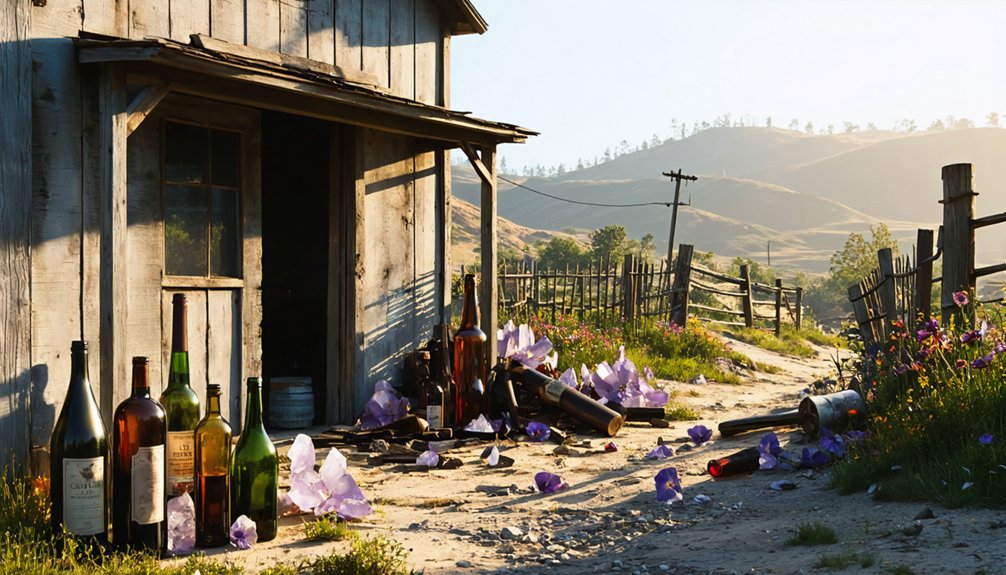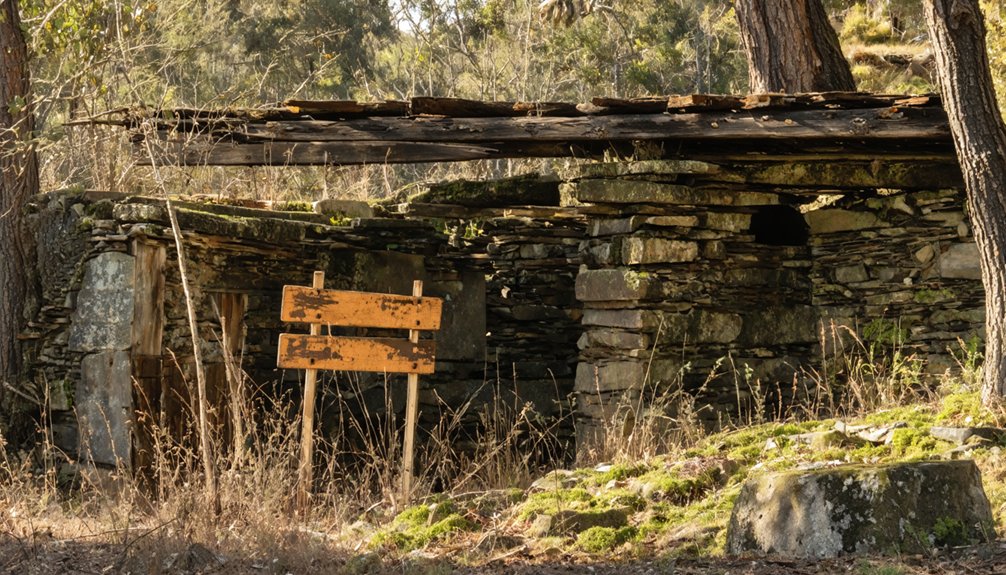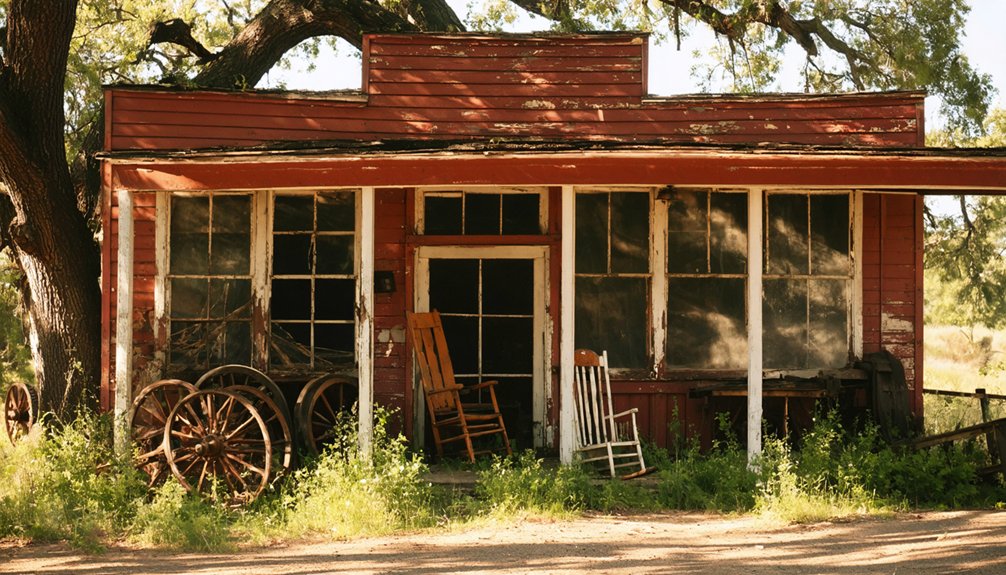Lower Calaveritas began as a Mexican mining camp in 1849, growing to a diverse boomtown of 700 residents with bustling fandango halls and commercial enterprises. You’ll find it nestled in Calaveras County’s Sierra Nevada foothills. Devastating fires, particularly in 1857, coupled with depleted gold deposits and the nearby copper boom, led to its abandonment by the mid-1900s. Today, crumbling stone foundations and an old cemetery mark this official ghost town‘s shadowy past.
Key Takeaways
- Lower Calaveritas was established in 1849 by Mexican prospectors during California’s Gold Rush before becoming a multicultural mining community.
- The town experienced multiple devastating fires between 1854-1874 that contributed to its economic instability and eventual decline.
- Once home to approximately 700 residents, the settlement was abandoned as gold deposits became unprofitable and miners sought opportunities elsewhere.
- Notable remnants include old mining structures, historic saloons, abandoned homes, and a cemetery reflecting the town’s 19th-century heritage.
- Now officially designated as a ghost town, Lower Calaveritas attracts tourists interested in California’s Gold Rush history despite its remote location.
The Founding of a Gold Rush Settlement (1849)
In the spring of 1849, as gold fever swept across California following James Marshall’s discovery at Sutter’s Mill, Mexican prospectors established Lower Calaveritas amid the rugged terrain of what would become Calaveras County.
Their founding motivations were clear—exploit the newly discovered surface gold deposits that promised quick wealth.
Gold fever drove them forward—the seductive promise of surface riches waiting to be claimed.
You’ll find this camp’s name reveals its character: “Calaveritas” meaning “little skull” in Spanish. The settlement emerged organically, reflecting the chaotic patterns of Gold Rush development.
While prospectors faced significant settlement challenges including isolation, limited supply lines to Sacramento and Stockton, and dependence on nearby water sources, they persisted. The Californio miners often encountered violence and discrimination from Anglo-American newcomers who sought to drive them from their claims.
The camp would later be joined by Upper Calaveritas, founded in fall 1850 by William Workman from nearby Angels Camp.
Like its neighboring town San Andreas, Lower Calaveritas attracted a diverse population of fortune seekers who established tents and rudimentary structures in their pursuit of gold.
Multicultural Mining Community at Its Peak
While Lower Calaveritas began as a Mexican mining camp in 1849, it quickly transformed into an international community as gold seekers from Chile, China, France, England, Germany, and the Eastern United States established themselves alongside the original settlers.
You’d have found a rich tapestry of languages and customs throughout the 1850s, with each ethnic group contributing distinct cultural elements to the community’s fandango halls, restaurants, and saloons.
African Americans, both free and enslaved, also arrived during this Gold Rush period, with some later gaining freedom and establishing businesses in the region.
The town reached its peak population of approximately 700 residents before beginning to decline in the mid-1870s as mining opportunities diminished.
Mexican Founding Influence
Founded by Mexican prospectors during the early Gold Rush of 1849, Lower Calaveritas quickly established itself as a distinctive multicultural mining settlement with deep Hispanic roots.
The name itself—”Calaveritas” meaning “little skull” in Spanish—reflects the Mexican heritage of its founding settlers who dominated early mining operations.
You’d have found vibrant cultural traditions thriving in the town’s fandango houses, which served as social centers where miners gathered after long days of labor.
These dance halls weren’t just entertainment venues; they preserved Mexican cultural practices amid the rugged mining landscape.
By 1853, the town had developed various businesses including livery stables, butcher shops, restaurants, and gambling houses that supported the mining community.
Joaquin Murrieta, the famous outlaw, frequently visited these establishments, adding to the town’s notorious reputation.
Despite being known as a dangerous locale, Lower Calaveritas maintained strong cultural connections to its Mexican origins throughout its brief but colorful existence.
The town was located in what became Calaveras County, one of California’s original counties formed after the state joined the United States following the Mexican War of 1848.
International Gold Seekers
The diverse tapestry of humanity that converged on Lower Calaveritas during its peak years of 1851-1853 transformed this once chiefly Mexican settlement into an international boomtown of remarkable cultural complexity.
You’d find over 30% of residents were foreign-born, with substantial Chilean, French, German, and Chinese populations forming supportive ethnic enclaves throughout the camp.
These international miners didn’t just contribute bodies—they brought specialized cultural contributions that revolutionized local operations. The Chinese introduced advanced sluicing systems, while Europeans shared expertise in tunneling and ore processing. Similar to other areas along the Mokelumne and Calaveras rivers, Lower Calaveritas attracted fortune seekers who established temporary camps that later developed into more permanent settlements.
This cross-cultural exchange of mining techniques created hybrid methods that dramatically improved efficiency and yields. The mining community here reflected the broader influence of the Gold Rush that significantly shaped California’s development and cultural landscape. Though language barriers and discriminatory taxes created tensions, cooperative periods fostered community cohesion through festivals and shared knowledge, leaving behind a multicultural legacy documented in artifacts, newspapers, and oral histories.
Diverse Cultural Exchange
Lower Calaveritas reached its zenith as a multicultural community between 1851 and 1853, when the initial Mexican settlement expanded into a vibrant microcosm of global society.
You’d have heard a dozen languages while strolling through town—Spanish, Italian, German, Chinese, and English voices haggling at general stores or sharing mining techniques.
The fandango halls became focal points for cultural festivals where miners from Chile danced alongside Frenchmen and Irishwomen.
Saloons and gambling houses served as more than mere entertainment venues; they functioned as community gathering spaces where cultural exchange flourished organically.
Here, a German miner might share a drink with a Mexican prospector, trading stories and mining wisdom.
This remarkable cultural tapestry woven from global threads created an atmosphere of mutual adaptation, as each group contributed to the evolving identity of the settlement.
Main Street Commerce and Town Layout
Main Street formed Lower Calaveritas’ bustling commercial center with saloons, fandango halls, and mercantile shops positioned strategically along both sides of the thoroughfare that paralleled Calaveritas Creek.
You’d have witnessed the devastating fire of 1857 sweep through the wooden structures, consuming nearly all commercial establishments in a single catastrophic night.
Merchants and proprietors quickly rebuilt with more substantial materials, though never restoring the street to its pre-fire vibrancy as many businesses relocated to the more prosperous Upper Calaveritas settlement. Like many settlements along Highway 49, Lower Calaveritas preserved elements of the gold rush era with remnants of old mining structures visible among the rebuilt establishments. The nearby town of Mokelumne Hill experienced similar challenges but managed to maintain its historic significance through the preservation of its western history.
Bustling Commercial Hub
Bustling with economic significance, Lower Calaveritas’ commercial district evolved into a highly organized urban center by the mid-1850s. You’d find commercial energy reflected in establishments lining both sides of Main Street, while dwellings occupied Back Street and Costa Road. This strategic layout separated commerce from residences, maximizing economic diversity while maintaining community cohesion.
- Stores, saloons, and fandango halls dominated the commercial landscape.
- The Adobe Costa Store (est. 1861) exemplified multi-generational family enterprise.
- Livery stables, hotels, and restaurants served miners and travelers.
- Butcher shops and distilleries operated continuously for decades.
- Clear zoning separated business corridors from residential areas.
This functional organization wasn’t accidental—it reflected mining camp conventions while creating a sustainable commercial environment that supported the town’s approximately 700 residents during peak prosperity.
Fire’s Devastating Impact
Despite its meticulous commercial organization, Lower Calaveritas suffered catastrophic disruption when fire engulfed the business district on August 20, 1859.
You’d hardly recognize Main Street afterward, with general stores and Wells Fargo offices reduced to ashes.
This wasn’t an isolated incident. Devastating fires in 1854, 1864, and 1874 repeatedly ravaged the town’s commercial core, triggering profound economic instability.
Merchants and miners alike faced financial ruin with each blaze.
The town’s very layout transformed in response. Buildings once crowded together were rebuilt with wider spacing for fire prevention.
Wooden structures gave way to stone and iron elements, exemplified by the Peter L. Traver Building with its protective iron shutters.
Water infrastructure placement shifted strategically to protect businesses, permanently altering the town’s commercial footprint and architectural character.
Rebuilding Efforts Post-1857
As the ashes of the August 1858 fire cooled, Lower Calaveritas’ determined residents launched an ambitious rebuilding campaign that would reshape the town’s physical and economic landscape.
Despite significant reconstruction challenges, community resilience prevailed as businesses quickly reestablished along Main Street, though never recapturing the town’s pre-fire population of 700-800 residents.
- Commercial establishments returned on both sides of Main Street—stores, saloons, and gambling houses
- Residential dwellings concentrated along Back Street (High Street) and present-day Costa Road
- Luigi Costa’s store, built in 1852, stood as the sole surviving original Gold Rush structure
- A diverse population from Mexico, Chile, France, Germany, China and the Eastern States contributed to rebuilding
- Settlement patterns followed Calaveritas Creek, constrained by the surrounding hills’ topography
The Devastating Fire of 1857
While prosperity had reached its zenith in Upper Calaveritas, tragedy struck the thriving mining community on August 3, 1858, when a catastrophic fire erupted from a vacant building in the town’s center.
The blaze reportedly originated from a vengeful act by a gambler named Shelton who, after losing his gold dust in a card game, set fire to the structure adjacent to the gambling hall.
Enraged at his gambling losses, Shelton ignited revenge upon Upper Calaveritas, forever altering the mining town’s destiny.
The conflagration quickly consumed fifty-one buildings, with damages exceeding $35,000—a devastating sum in those days.
You’d have witnessed the town’s rapid decline in the fire aftermath, as most structures weren’t rebuilt due to depleted placer deposits.
Miners abandoned their claims to seek fortune elsewhere, and community resilience faltered as families departed, leaving the once-bustling settlement nearly deserted.
Daily Life in a Frontier Mining Camp

Before the fires claimed Calaveritas, the rhythms of daily existence defined frontier mining life in ways both harsh and hopeful.
You’d rise at dawn, laboring until dusk in search of elusive gold using rudimentary tools—the mining hardships testing your resolve daily. Your home would’ve been little more than a wooden cabin or canvas tent, offering minimal protection against the elements.
- Your social activities centered around saloons and fandango halls, where gambling and drinks provided rare respite.
- You’d face constant health threats from poor sanitation and limited clean water.
- Your community would show remarkable resilience when disputes arose, often creating informal justice systems.
- You’d interact with diverse occupations beyond miners—blacksmiths, carpenters, and merchants.
- Your meals were simple, entertainment scarce, but community bonds strong.
Decline and Abandonment of Lower Calaveritas
Lower Calaveritas began its inexorable decline in the late 1850s, when the once-bountiful placer deposits that had drawn enthusiastic prospectors steadily diminished to unprofitable yields of less than two ounces per day.
You’d have witnessed a rapid economic decline as miners abandoned their claims, unable to afford the capital-intensive hydraulic and drift mining operations that replaced simple panning.
By the 1860s, many had relocated to larger centers like Angels Camp and San Andreas, where consolidated mining operations offered employment.
The mining shifts proved fatal for Lower Calaveritas. When copper boomed in nearby Telegraph City during the Civil War, it drew away remaining capital and labor.
Archaeological Discoveries and Indigenous History

Long before gold-hungry prospectors transformed the Calaveras landscape, indigenous peoples had established complex societies throughout the region, with archaeological evidence suggesting human habitation dating back thousands of years.
The ancient footprints of California’s first peoples remain etched in Calaveras’ soil, predating the Gold Rush by millennia.
The area’s archaeological significance emerges through stratified excavation sites, particularly at Skyrocket in Salt Springs Valley.
- Indigenous artifacts discovered include Clovis-style projectile points and flaked stone tools used for hunting and food processing.
- Middle Archaic settlements featured corner-notched dart points, mortars, and subterranean storage pits.
- Technological advancement appears with the bow and arrow introduction around 1100 BP, replacing the atlatl.
- The controversial Calaveras Skull (1866) was eventually proven to be less than 1,000 years old, not millions.
- Miners unearthed hundreds of authentic indigenous artifacts from gold-bearing Tertiary gravels beneath basalt layers.
What Remains Today: Visiting a Mother Lode Ghost Town
Standing amid the scattered remnants of Lower Calaveritas today, you’ll find yourself confronted with a haunting tableau of California’s gold-fevered past. This ghost town offers little regarding intact structures, with Luigi Costa Store—California Historical Landmark No. 255—standing as the sole significant survivor.
You’ll navigate unpaved rural roads to reach this forgotten corner of the Mother Lode. No visitor centers welcome you; no interpretive displays guide your exploration. Instead, you’ll discover building foundations, scattered mining debris, and overgrown pathways that hint at the town’s original layout.
The site’s historical significance lies in what’s missing rather than what remains. Bring sturdy shoes, water, and an appreciation for atmosphere—this isn’t a curated experience but an encounter with time’s relentless march.
Frequently Asked Questions
Were There Any Famous Individuals Who Lived in Lower Calaveritas?
No famous residents lived permanently in Lower Calaveritas. You’ll find notable events like Joaquin Murrieta’s visits and gambler Shelton’s destructive 1858 fire, but no celebrated permanent inhabitants.
What Were the Common Crimes and Legal Issues in Lower Calaveritas?
In the wild frontier days, you’d witness nefarious activities flourishing—petty theft of gold dust, mining disputes over claims, arson, gambling altercations, and lawlessness fueled by saloons where outlaws like Murrieta roamed freely.
How Did Women Contribute to the Community’s Development?
You’d find women serving as caregivers, entrepreneurs, and community organizers. Their social contributions included healthcare, business ownership, and cultural preservation, while their community roles encompassed education, family management, and solidarity-building amid challenging frontier conditions.
Were There Schools or Educational Facilities for Children?
Pioneering parents provided your children’s educational history through community schooling. You’d find nearby Douglas Flat School (1854) and Cave City School District (1855), with regional consolidations reflecting your freedom to adapt amid Gold Rush challenges.
Did Lower Calaveritas Have Unique Mining Techniques or Technology?
You won’t find unique extraction methods at Lower Calaveritas. They used standard Gold Rush techniques—pans, rockers, sluices, then hydraulic and drift mining—with historical machinery mirroring other Calaveras County mining camps.
References
- https://monkeysventures.com/gold-ghosts-gems-and-giants-of-calaveras-county-ca-part-1/
- https://sierranevadageotourism.org/entries/calaveritas-no-255-california-historical-landmark/e3be5582-7ead-4d07-91b0-2f7893c0ef78
- https://www.gocalaveras.com/history/
- https://www.malakoff.com/goldcountry/calaveri.htm
- https://beyond.nvexpeditions.com/california/calaveras/calaveritas.php
- https://www.calaverashistory.org/calaveritas
- https://www.marieelenaphotography.com/black-californians-who-shaped-calaveras-county
- https://www.historichwy49.com/angel/calavhist.html
- https://en.wikipedia.org/wiki/Calaveritas
- https://travelingboy.com/travel/unruly-past-1849-california-gold-rush/



